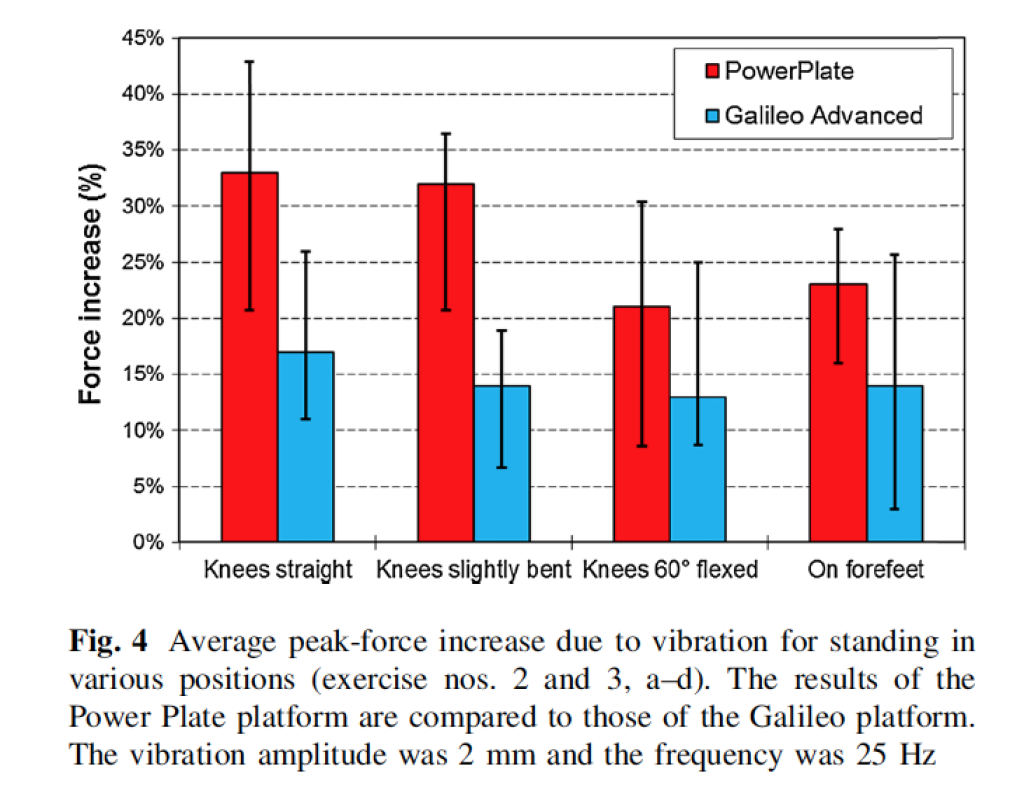What are the Differences between Galileo Side-Alternating Vibration Training and Vertical Device Training
Galileo is the most well documented system of vibration training with hundreds of published articles in scientifically recognized and reviewed journals. Below are some of the ways in which Galileo Training is fundamentally different than training on vertical devices (non side-alternating).
1. Type of vibration
 Side-alternating vibration training Side-alternating vibration training |
Vertical vibration training |
|

Side-alternating vibration.Tilting movement – left and right side of the plate move up and down alternately. Simulates human gait.Physiological movements e.g. when walking or running are simulated by Galileo plate motion.
When walking, the same muscles of the right and the left side of the body are never used at the same time in the same way – but always alternately! |

Non side-alternating vibration – the whole plate moves up and down.Predominantly vertical movement – left and right side of the plate move up and down at the same time.The non-side alternating up and down movement of other vibration training devices does not correspond to typical human locomotion such as during running or walking. Humans don’t normally move by hopping. |
2. Influence of side-alternating vibration on back muscles
 Side-alternating vibration training Side-alternating vibration training |
Vertical vibration training |
| The side-alternating motion of Galileo causes an alternating force induction in the legs that is transferred to the pelvis. This lateral tilt of the pelvis leads to an alternating activation of the back muscles (similar to physiological movements like walking or running). |
By simultaneously lifting both legs the pelvis is not tilted but only moved vertically. The lacking relative motion between pelvis and back results in a diminished training effect. |
3. Step less adjustment of training parameter for different training goals
 Side-alternating vibration training Side-alternating vibration training |
Vertical vibration training |
Frequency: Galileo offers adjustable frequencies between 5 and 40 Hz. The training goal determines the frequency range.
- 5–12 Hz – Mobilization
active compensation of the tilt movement. Tension relief/muscle relaxation. Improvement of balance and proprioception.
- 10–20 Hz – Muscle function
from 12 Hz on the stretch reflex is triggered. Improvement of muscle function, coordination, muscle relaxation, stretching of muscles and tendons.
- 20–40 Hz – Muscle power
increase of muscle tone, improvement of muscle power and re-establishment of muscle force.
|
Frequency: Normally adjustable between 20 and 60 Hz. Therefore vibration training below 20 Hz is normally not possible (only a few machines support frequencies below 20 Hz). |
| Amplitude:Amplitudes between 0 and 6 mm (corresponding to an upstroke of 0 – 12 mm) can freely be chosen depending on foot position.Any possible combination of frequency and amplitude with variable selection of frequency and amplitude. |
Amplitude:The majority of machines offer few or only one amplitude, normally 1 to 2 mm (corresponding to an upstroke of 2 to 4 mm).Considerably reduced maximum amplitudes and markedly reduced variability of training parameter. |
4. Reproducibility of the generated forces
 Side-alternating vibration training Side-alternating vibration training |
Vertical vibration training |
Highly accurate and reproducible motion of the vibrating platform due to the mechanically guided movement (shaped force).
The design of Galileo always guarantees a purely sinusoidal (harmonic) motion of the vibrating platform, regardless of body weight and stiffness of the user.
This allows an objective assessment and comparability of training parameters and therapeutic results, which is a crucial prerequisite for the use of vibrating exercise equipment in scientific studies. |
No mechanically guided movement
(no shaped force). |
5. Transmission of vibrations to the head
 Side-alternating vibration training Side-alternating vibration training |
Vertical vibration training |
| The side-alternating principle results in a very low vibration being transferred to the head: The tilting motion of Galileo causes an alternating application of force in the legs, which are transmitted to the pelvis. This lateral tilt of the pelvis leads to an alternating activation of back muscles, analogous to physiological movements such as walking and running. The spine, therefore, runs into the rotational axis of the lateral pelvic motion, which minimizes the vertical movement of the spine and the head.. |
The head vibrates much more:
The simultaneous lifting of both legs causes no tilting in the pelvis, but a varying vertical acceleration depending on the leg stiffness. The lack of any compensatory movement of the pelvis results in a significantly higher movement of the spine and thus the head than in the side-alternating movement. |
Galileo generates much less force to the body than Power Plate.

Galileo generates much less force to the body than Power Plate.
PAGES to read on GALILEO CONCEPT
Galileo Basics
Frequency Matters
Forces
Muscle-Bone Relationship
Vibration Types
Indications
Contraindications
Side Effects

